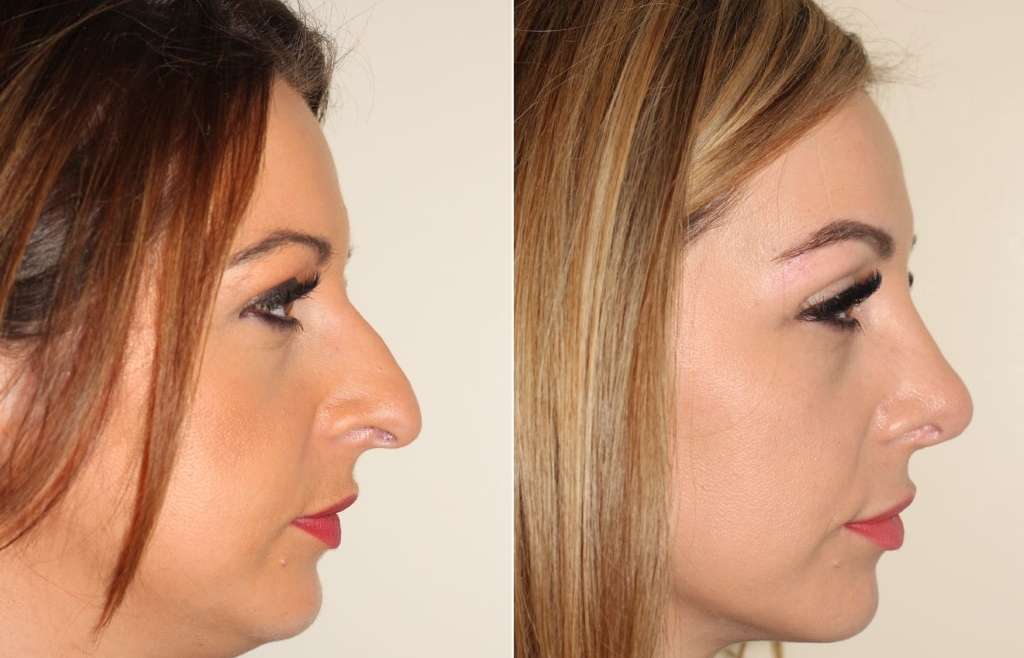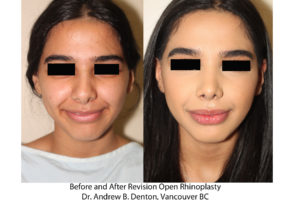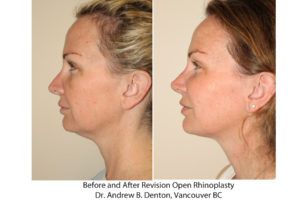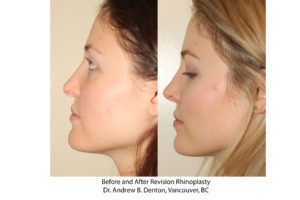Are you dissatisfied with the results of your rhinoplasty surgery? We can help. Dr. Denton is highly qualified and experienced in performing Revision Rhinoplasty Surgery. This cosmetic surgical procedure involves correcting or improving the appearance and sometimes function of the nose following rhinoplasty surgery. According to research, 5% to16% of patients, who have undergone a rhinoplasty procedure, are disappointed with the results and seek to repair
aesthetic and/or functional issues.
*Click on each pair of images to enlarge
The Procedure
This surgical procedure is typically more complicated and difficult than a primary rhinoplasty due to the presence of scar tissue. The fact that excessive resection of cartilage and other structural elements within the nose usually occur during the primary rhinoplasty also make this secondary nose reshaping surgery more challenging.
Commonly, revision rhinoplasty involves rebuilding the nasal bridge or tip. Due to the removal of cartilage during the primary rhinoplasty, the cartilage to rebuild the nose is normally taken from the nasal septum, ear, or, in some cases, ribs.
Another reason why this procedure is more challenging is that secondary-scar healing can be more unpredictable. Consequently, it is vital that a primary rhinoplasty has had enough time to heal completely before attempting a revision rhinoplasty. This means that rhinoplasty patients may have to wait from one to two years to undergo a revision rhinoplasty.
Open or Closed Surgical Approach?
Due to its complex nature, a revision rhinoplasty is normally performed using the open or external surgical approach. This provides the surgeon with better access and visibility of the scar tissue and structure of the nose in order to precisely and effectively reconstruct or reshape the nose. In Dr. Denton’s hands, the surgical procedure is safely and comfortably performed using twilight anesthesia at his Vancouver clinic. Normally, it will take between 90 minutes and 2 hours to complete, which can be longer than a primary rhinoplasty.
The Healing Process
The healing process of revision rhinoplasty, as one might expect, is longer than that of a primary rhinoplasty. This is because the scar tissue from the primary rhinoplasty slows the reduction of surgical swelling after revision rhinoplasty. However, if the revision rhinoplasty involves minor changes then the swelling dissipates much more quickly.
In order to assess the final result of the procedure, it normally takes from one to two years until the nasal tissues “settle permanently.” Again this will depend on the extent of the surgery. Finally, when the healing process is completed then changes will be permanent – apart from the changes that occur due to aging, of course.
Choosing Your Revision Rhinoplasty Surgeon
Even though rhinoplasty is one of the most common cosmetic facial surgical procedures, it is quite a complex and challenging procedure. If you are considering revision rhinoplasty, it is highly recommended to consult a leading board-certified Facial Plastic Surgeon, like Dr. Denton, who is highly experienced in this procedure and has a clear understanding of the nasal structure and the surgical techniques required to perform it flawlessly and provide you with the desired results.
What’s more, since no revision rhinoplasty procedure is the same the surgeon needs to take time to consult with the patient and establish a customized treatment plan. This will reinforce the patient’s confidence, especially when computer imaging is used to reflect the anticipated changes. Dr. Denton’s philosophy is that the patient must be an equal member of the decision-making team so that he or she can make sound informed decisions and will be aware of the expected result.
To learn more about revision rhinoplasty and whether it is right for you, schedule your consultation here today. Dr. Denton can help you achieve the result that will make you feel more confident about your appearance.




